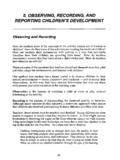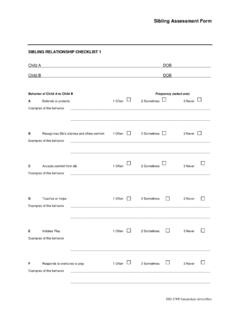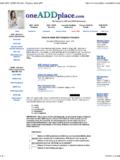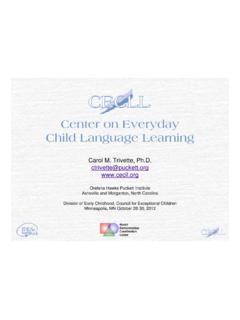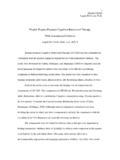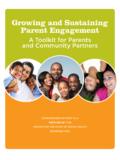Transcription of Standards for School Age Child Care Programs
1 Standards for School Age Child care Programs Revised July 31, 2012 Amended November 6, 2012 Learning Environment There is substantial evidence that: Program environment features are central to program quality and there is limited evidence that varied and appropriate program materials support children s development. Quality of staff- Child interactions contributes to quality in out-of- School time settings and substantial evidence that children with involved and responsive caregivers fare better on a wide variety of Child development measures. Developmentally appropriate curriculum is related to other measures of program quality Developmentally appropriate curriculum is related to positive Child and youth outcomes.
2 There is a moderate amount of evidence that: Developmentally-appropriate assessment is associated with improved Child and youth development outcomes. Program Environment Documentation1 PE 1. Program staff attend training on the School Age care Environment Rating Scale (SACERS). Evidence of training completion. PE 2. Program2 staff complete a self -assessment on the School Age care Environment Rating Scales (SACERS)3, NYSAN Quality Self-Assessment (QSA) Tool, and/or ASWNY Accreditation Self-Study materials. Self-assessment report. PE 3. Program completes a self-assessment and writes an improvement plan to address: SACERS subscale scores below , or Ratings of 0 or 1 on ASWNY Self-Study or Areas identified as in need of improvement in QSA Tool Action Plan.
3 Completed: ERS self-assessment report with improvement plan, OR NYSAN QSA action plan, OR ASWNY self-study plan for improvement PE 4. Program has an independent SACERS4 observation and assessment and achieves an overall score of Written Completed SACERS report with written improvement plan. 1 All documentation requirements are subject to change. Documentation listed in bold text is required and must be submitted for credit. Documentation listed in regular text is optional; at least one form of documentation must be submitted to receive credit for meeting the standard. 2 Program means all types of out-of- School time settings such as community centers, Child care centers, public or private schools non- School hours, parks, libraries, etc.
4 3 The School Age care Environment Rating Scales (SACERS) is one of a family of tools to measure program quality. These include the Early Childhood Environment Rating Scale, revised (ECERS-R); the Infant/Toddler Environment Rating Scale, revised (ITERS-R); the Family Child care Environment Rating Scale, revised (FCCERS-R) and the School Age care Environment Rating Scale (SACERS). NOTE: no-cost training will be offered on introduction to the ERS and introduction to QUALITY starsNY. 4 NOTE: ERS assessment will be offered at no cost to Programs . Page 2 of 15 improvement plan for subscale scores below PE 5. Program has independent SACERS observations and assessment using the appropriate scale(s) and achieves an overall score of Written improvement plan for subscale scores below Completed SACERS report with written improvement plan.
5 PE 6. Program has independent SACERS observation and assessment using the appropriate scale(s) and achieves an overall score of or higher. Written improvement plan for subscale scores below Completed SACERS report with written improvement plan. Youth Observation and Assessment Documentation YOA 1. Program collects information at enrollment related to children s social, emotional, academic, and physical development; dominant language; and any special needs. Copies of at least 3 sample completed questionnaires and or sufficiently robust enrollment forms. YOA 2. Program documents relevant information about each Child s social, emotional, academic, and/or physical development within 45 days of enrollment using a systematic screening process aligned to program content.
6 Copy of systematic and/or screening process or tool Copies of 3 developmental screening tools/enrollment form to conduct assessment (with identifying info removed) YOA 3. Program regularly documents the progress of children s social, emotional, academic, and/or physical development. Copies of at least 3 samples of written records used by program to document progress (with identifying info removed). Copy of written policy describing how youth assessments inform program design and implementation. YOA 4. All lead staff ( site coordinators and program directors) has annual training in youth observation and assessment, including recognition of developmental milestones and identifying possible developmental delays, and linking youth observation and assessment to program design and implementation.
7 Training as indicated by Aspire. YOA 5. Program can document that information on children s progress is used to inform program practice. Statement of how program uses children progress information to Aggregated data reports Improvement plan(s) Page 3 of 15 Curriculum5 Planning and Implementation Documentation CPI 1. The program has a written education and/or youth development philosophy. Copy of education and/or youth development philosophy statement CPI 2. The program selects and/or develops and uses a written curriculum / curriculum framework that is developmentally appropriate and addresses the key domains of Child and youth development.
8 Copy of curriculum/ curriculum framework CPI 3. The program uses a curriculum / curriculum framework that is evidence-based, meaning it is grounded in science and is shown to improve Child outcomes. Copy of curriculum or curriculum framework CPI 4. Program curricula align with the NYSED Learning Standards and/or Social Emotional Learning and Development Name and publisher of curricula Completed curriculum crosswalk CPI 5. The program uses curricula that are responsive to youth of different genders, races/ethnicities, languages, and abilities. Evidence of adaptation or other evidence of culturally competence (lesson plans, activities) CPI 6.
9 Appropriate program staff receives training and supervision support from their organization, School district, funding agency, and/or an intermediary partner to implement the curricula. Training certificates Evidence in Registry Training logs CPI 7. Program uses activity guides, curricula, specific techniques, and/or other protocols to minimize transition time within program activities so that children remain occupied and are kept engaged throughout activities and transitions. Name and publisher of curricula Assessment tool and explanation of connection CPI 8. Program seeks information from, and coordinates with, feeder schools to offer activities that are linked to School -day content and skills.
10 Weekly or daily lesson plans Individualized learning goals based on Child observations and assessment. Physical Well-Being and Health Documentation PH 1. Program has a policy that details the use of TV/video for youth. When used, TV/video should be of high-quality educational or movement-based commercial-free programming for purposes of extending learning and integrating or enriching the curriculum. Evidence of policy PH 2. Program provides opportunities for youth to learn healthy nutrition and/or active play practices that lead to healthy weight. Copy of program schedule Weekly or daily lesson plans 5 Curriculum means the goals for knowledge and skills to be acquired by children and the plans for learning opportunities through which such knowledge and skills will be achieved 6 See for more information Page 4 of 15 PH 3.

